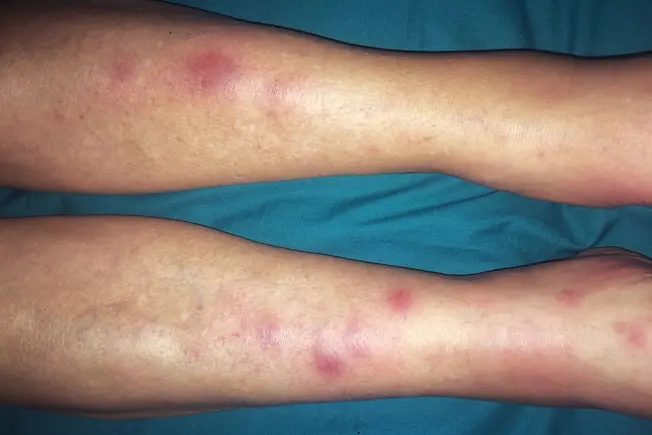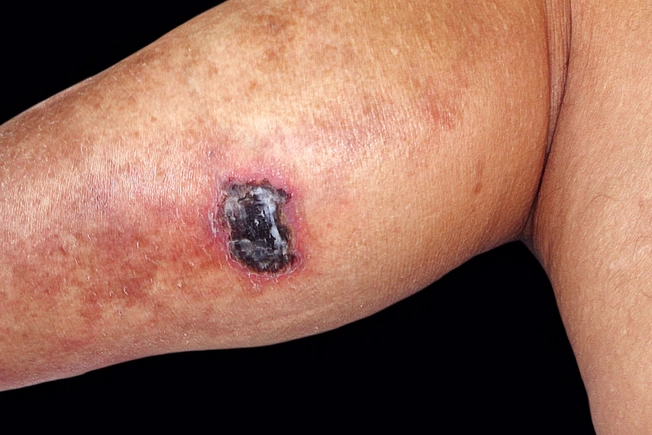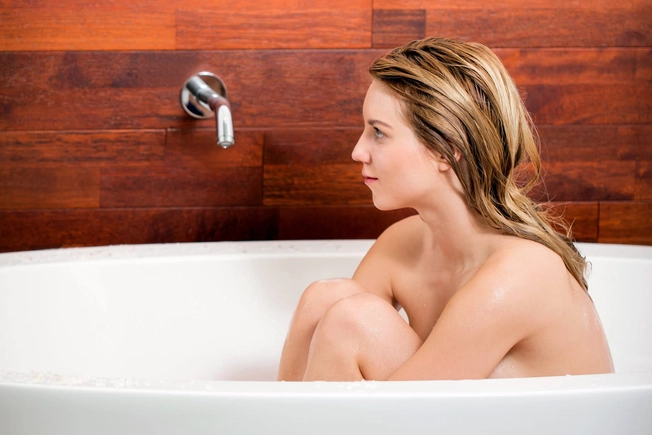Skin Problems Linked to IBD


Erythema Nodosum
It causes tender, reddish lumps usually on your shins, which can look like bruises. It may start with flu-like symptoms such as fever and aching. It’s the most common skin problem linked to inflammatory bowel disease (IBD) and is related to your immune system’s response to bowel bacteria. The bumps tend to show up when your IBD flares and go away when you treat it. To ease the pain, keep your legs elevated and apply a cool compress. Pain relievers, like ibuprofen or naproxen, may help, too.

Pyoderma Gangrenosum
It’s the next most common skin problem for people with IBD, and the most severe. It starts with a small, red bump, usually on your legs or near where you’ve had surgery. Within hours or days, it grows into a large, painful sore or ulcer. Doctors aren’t sure of the cause. It can be tough to treat. The most common treatment is daily steroids, along with wound care and medications you rub on your skin.

Fissures
IBD can cause small tears in the skin around your anus. They can cause blood in your stool and pain during a bowel movement. Most heal on their own, but warm baths and ointments can ease pain or itchiness. If the fissure doesn’t go away by itself, your doctor may prescribe medicine to help relax the muscles in that area, which allows the tears to heal.

Acne
Some medications that treat IBD can cause skin problems as a side effect. Steroids can cause severe acne and a puffy face. Other side effects of these drugs may include stretch marks, thin skin, ankle swelling, and slow wound healing.

Psoriasis
It’s a disease that can cause red, dry, scaly, itchy skin and soreness. Researchers aren’t clear on how it’s linked with IBD, but people with Crohn’s disease are eight times more likely to have psoriasis. It may be a combination of your genes and immune system that puts you at risk for both diseases. You can treat it with creams, medicine you take by mouth, or light therapy.

Enterocutaneous Fistulas
It’s a small tunnel between your intestines and your skin, usually from the rectum to the vagina, bladder, or buttocks. It may leak waste or pus and cause pain or swelling. It’s more common with Crohn’s disease than with ulcerative colitis. Fistulas are complicated to treat. Depending on where it is and how bad it is, you may need medication or surgery.

Skin Tags
About one third of people with Crohn’s disease have skin tags around their anus. They happen because of swelling from hemorrhoids. When the swelling goes down, the skin gets thicker and forms either large, hard flaps or flat, soft, painless ones. If waste sticks to the tags, it can irritate your skin. Good hygiene is the best way to prevent discomfort from skin tags.

Canker Sores
Small mouth sores or ulcers can pop up inside your mouth during IBD flares or as a side effect of medication you take for the condition. They may make it uncomfortable to eat acidic, spicy, or hot foods. Sores should go away as you treat your Crohn’s or UC. Special mouthwash can also help clear up the sores.

Acrodermatitis Enteropathica
If your IBD leads to ongoing diarrhea, you may lose zinc in your stool. This could cause acrodermatitis enteropathica, a disorder that causes a flaky rash or blisters usually on your hands, feet, face, or genitals. Treatment is simple: Take a zinc supplement.

Pyoderma Vegetans
It’s a rare condition, and it affects people with ulcerative colitis. Like many skin issues related to IBD, researchers believe it’s caused by problems with the immune system. Pyoderma vegetans leads to blisters or patches around the groin or under the arms, which get darker as they heal. There is no standard treatment, but treating the IBD itself is key.

Leukocytoclastic Vasculitis
Vasculitis means “inflammation of the blood vessels,” and leukocytoclastic refers to immune cells that build up in blood vessel walls. It’s a rare condition. Doctors think it’s caused by immune problems that come with IBD. It looks like raised red spots on your legs and feet. They are sometimes itchy or painful. If it’s severe, they might turn into open sores or large blisters. Vasculitis usually goes away with IBD treatment.

Vitiligo
Vitiligo makes your skin lose its color in blotches. It’s slightly more common in people with IBD, maybe because of a genetic link or because of something related to the immune system. Treatments include medicines, creams, and light therapy.

Clubbing
With this condition, the skin under your nails gets thicker, which causes your fingertips to get bigger and your nails to curve around them. If you have IBD, you have higher odds of finger clubbing, perhaps because of certain chemicals in your blood. There is no treatment, but managing your IBD may help it get better.

Epidermolysis Bullosa Acquisita
If you’ve had Crohn’s disease for many years, you may be more likely to get this disorder. It causes blisters on your knees, elbows, hands, and feet. It could be caused by ongoing inflammation in your intestines. Steroids and other types of medicine can treat epidermolysis bullosa, but you should also avoid contact sports or anything that could harm your skin.

Sweet’s Syndrome
It starts with a fever and small red bumps that appear quickly on your arms, neck, head, or the trunk of your body. The bumps grow into a painful rash. Doctors don’t know exactly why, but Sweet’s syndrome can appear in response to IBD. You can treat it with steroids, either in pill form or a cream, but it’s common for Sweet’s syndrome to come back.